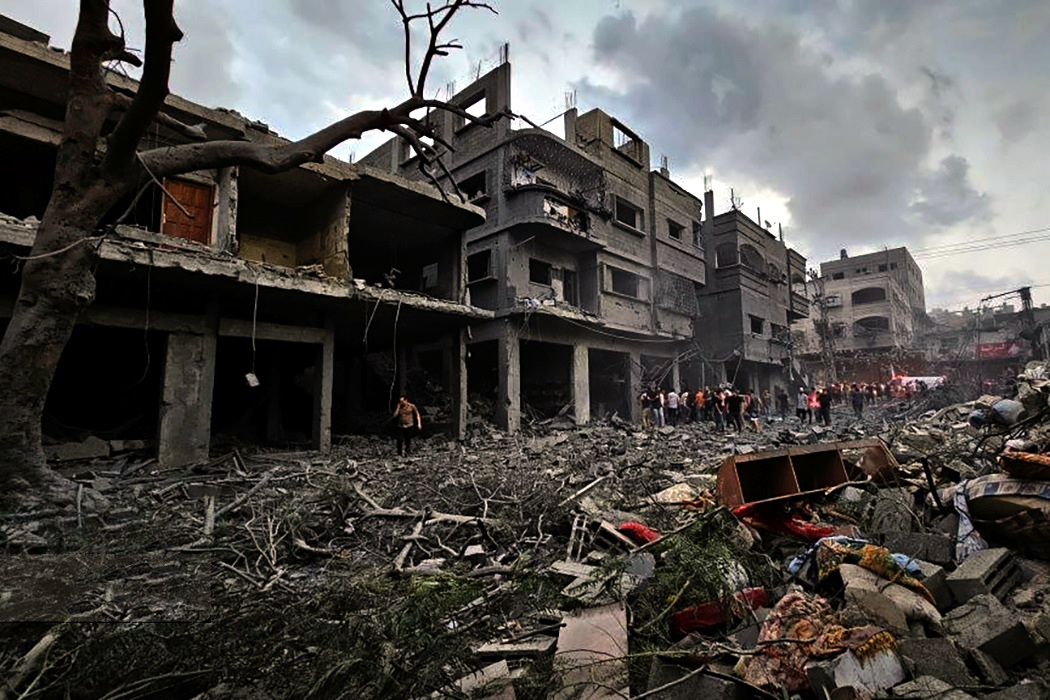Contextualizing the campus “Palestine Solidarity encampments”
Destruction in the Gaza Strip from the Israel-Hamas War. / Photo credit: Wikimedia Commons
By Anonymous
Students across American college campuses have set up “Palestine Solidarity encampments,” demanding their administrations divest from Israel. Many view these as antisemitic and some have urged for them to be shut down. An op-ed in the Penn Post described the encampment at Columbia as a “jihadist mob” making “daily life hellish for Jewish students.” However, the piece did not mention what the protests were actually about; the word Gaza does not appear once and genocide is cited only for the “genocide of Jews.” The author doesn’t acknowledge any legitimate concern about the actions taken by the Israeli government and prescribes only a motivation of antisemitism. The slogan “Free Palestine” only makes sense if you understand all the ways in which the Palestinians are not free. In order for us to properly contextualize the protests themselves, we must first understand the actions of the state that they are protesting.
The story must begin before October 7th. On October 6th, Israel controlled the area between the Mediterranean Sea and the Jordan River, in a situation described by the international human rights organizations Amnesty International and Human Rights Watch, as well as Israel’s own agency B’tselem, as “apartheid.” The West Bank and Gaza, conquered by military force, are considered occupied territory under international law, making continued Israeli control and the establishment of Jewish settlements illegal. The Israeli Defense Forces (IDF) directly controls 61% of the West Bank, where it supports settlement expansion while preventing all Palestinian construction. Most Palestinians live in enclaves under the Palestinian Authority, a corrupt dictatorship supported by the US and the EU. Within the West Bank, the IDF can arrest any Palestinian and hold them in administrative detention for an indefinite length of time, with no lawyer and without charge. Israeli settlers in the West Bank are full citizens, voting in Israeli elections and subject to the civilian criminal justice system. The Palestinians, however, have no say over the occupation which governs much of their lives. Their movements are controlled by checkpoints and a border wall, while villages face frequent attacks from settlers.
In Gaza, the situation was even worse. Since 2007, Israel and Egypt have imposed a permanent land, sea, and air blockade that drastically limits all goods coming in and out. For the people of Gaza, it is almost impossible to visit family in the West Bank, to receive medical treatment, or to go abroad. This means that Gaza’s children, who make up the majority of its population, have lived their entire lives within the twenty-five by-five-mile ghetto. Israel withdrew its military from Gaza in 2005, but because Israel controls the borders, airspace, electricity, water supply, and even the population registries, international bodies still consider it occupied territory. Gaza has no functional economy, with massive unemployment and 80% of the population dependent on foreign aid. Every few years since the withdrawal, Israel has commenced operations that have bombed the strip, or “mowing the grass,” as referred to by Israelis.
One can respond that all these measures, the blockade, the checkpoints, the wall, and the mowing of the grass are necessary for Israeli security. Any state would implement measures to protect themselves against groups bent on their destruction. But a “necessary” apartheid is still apartheid. While Palestinians are not free, Israelis are not safe.
On the morning of October 7th, Hamas unleashed a massive rocket barrage against Israel. Simultaneously, groups of fighters from various militant groups broke through the fence and stormed military bases. They then entered a series of border communities and went house to house murdering people. Many were tied up before being shot, while houses were burnt down with their inhabitants inside. The most horrific atrocity took place at the Nova music festival where gunmen killed 364 young partygoers. A UN report found “reasonable grounds to believe that conflict-related sexual violence occurred.” In total, the attack killed around 1200 people, 766 of them civilians, while 253 hostages were taken back to Gaza.
On the night of October 7th, the IDF began airstrikes against targets in Gaza. The IDF spokesperson Daniel Hagari explained that the bombings are “focused on maximum damage.” According to investigations by an Israeli magazine, Israel used AI programs to generate lists of buildings and people to target. Another system tracked suspected Hamas members entering their homes, where an airstrike would then level the entire building killing the militant’s family and any other residents. Each attack was authorized to kill a certain number of civilians as “collateral damage,” usually 15 in the case of low-level Hamas members and over a hundred for senior members.
On October 9th, Defense Minister Yoav Gallant announced a full siege of the Gaza strip, ordering “ no electricity, no food, no fuel, everything is closed.” He further stated that “we are fighting human animals and must act accordingly.” It would be two months before any humanitarian aid was allowed across the Israeli border with Gaza.
On October 13th, the Israeli government issued orders for 1.1 million inhabitants of Northern Gaza to evacuate South. These evacuation orders were backed by the intensive bombing. However, despite delimiting safe zones, every area of Gaza has experienced bombing. The danger in the South, the difficulty in moving a million people over two roads, and the natural reluctance to abandon everything they own meant that some estimated 350,000 civilians remained in the North.
On October 27th, Israel began a direct ground invasion. Their soldiers moved into and occupied large swaths of the Gaza Strip, much of which had already been destroyed. An investigation by the Israeli newspaper Haaretz detailed the IDF policy of establishing “kill zones,” an area in which all Palestinians are considered combatants. A reserve officer reported that “as soon as people enter it, mainly adult males, orders are to shoot and kill, even if that person is unarmed.” Everyone killed is then considered a terrorist. The IDF officially claims that all combat zones are marked in advance and that civilians are notified, but in reality, the zone is determined by the commanders on the ground, with no clear markings. This policy helps to explain the many videos of the shooting of unarmed civilians waving white flags, including that of three Israeli hostages, killed in December. One disturbing video clearly shows a multiple missile striking a group of unarmed men until they all were dead.
Not all of the violence, however, has been indiscriminate. The invasion has also featured the demolition of dozens of buildings. After video of the demolition of Israa University got onto social media, the IDF first claimed that the building was used by Hamas and then later claimed it was a mistake and the commander had been censured. However, they have now destroyed every other university in Gaza, a result so systematic that it’s impossible to explain except as the result of intentional policy. According to sources within the IDF, Israel systematically bombs “‘power targets,’ which includes high-rises and residential towers in the heart of cities, and public buildings such as universities, banks, and government offices,” designed to encourage “Palestinian society … [to] exert ‘civil pressure’ on Hamas.” The UN Office of Human Rights has also alleged that Israel has targeted journalists, 122 of whom have been killed as of February. This is a truly staggering number, difficult to explain as 122 cases of misidentification.
As the war continued, Israel pushed south in Khan Younis. It has engaged in counter-insurgency warfare, holding positions and then abandoning them, trying to destroy Hamas by flooding tunnels and killing militants. For all the violence, this campaign has proved incredibly ineffective. At the end of January, Israeli officials announced that 80% of Hamas’s tunnels were still intact. Once Israel leaves an area, Hamas often moves back in, proving that even after half a year of war, the organization remains very much intact.
In the last week of November, a one-week ceasefire led to the release of 50 hostages by Hamas, 150 prisoners by Israel, and aid to enter Gaza. The war resumed. On December 6th, an airstrike killed the famous poet Refaat Alareer and six members of his family, “surgically targeted” at Alareer’s apartment.
Starvation grows in Gaza. Throughout the war, Israel limited the entry of humanitarian aid. To understand the extent of the aid blockage, compare the daily truck totals found here, to the undisputed number of 500 trucks per day before the war. Israel’s response that Hamas steals humanitarian aid concedes a policy of deliberate starvation of Hamas and therefore the entire population. Even once inside Gaza, the distribution of aid is difficult. Distribution in a warzone would be difficult normally, but the IDF has additionally attacked aid convoys.
On February 29th, Israeli forces fired on hungry Palestinians at an aid convoy, killing over 100 and wounding over 700. A CNN investigation “casts doubt on Israel’s version of events,” finding eyewitness testimonies and video evidence show the event to be a massacre. Between January 25th and March 21st, there were “26 attacks on civilians waiting for much-needed supplies” at this location. The so-called flour massacre does not appear to be an aberration. Humanitarian workers have also been attacked. According to the UN Security Council, 224 humanitarian workers have been killed in Gaza. These attacks made worldwide headlines on April 1st when a series of airstrikes killed seven workers from World Central Kitchen.
Due to the restriction of aid and the attacks on convoys, much of Gaza is unsurprisingly starving. A report from the IPC, the world leader on famine monitoring, found “at least one in four households (more than half a million people) in the Gaza Strip are facing catastrophic acute food insecurity conditions,” while 55% experience “emergency” food shortage, and the rest are at “crisis” levels. These terms denote the highest levels of possible starvation. This is what protestors refer to when they accuse Israel of genocide.
Despite all of the international backlash and public criticism, Israel now threatens to invade Rafah, a tiny enclave packed with over a million people. The United States warns against it while authorizing an additional 15 billion dollars in aid. The bombing continues. On April 26, an airstrike killed the daughter of Refaat Alareer, along with her husband and two-month-old baby. April 29th, bombings in Rafah killed 22 people, including a 5-day-old child. When will the bombing be enough?
All of these crimes are being committed by a Jewish state. Does this make it antisemitic to oppose them? Readers might be shaking their heads, upset that this piece spent so little time discussing the crimes of Hamas, but Israel chose to attack aid convoys and destroy Gaza’s universities. The excuse that Hamas hides in civilian infrastructure rings hollow when almost 300,000 buildings have been damaged or destroyed. This is indiscriminate destruction. While Israel might absolve itself of blame, the world cannot be expected to rest on the word of the IDF spokesperson. This war marks the end of an era where Israel’s defenders can just call their opponents antisemites and shut down the discussion.
This is the context often missing from the discussion of campus protests. There have been real incidents of antisemitism on campus (such as shouts of “Go Back to Poland,” but many situations have been intentionally exaggerated, such as a widely repeated claim of a Yale student “stabbed” in the eye (judge the video for yourself) or the common notion of people obstructed “because they are Jewish,” when these situations usually stem from pro-Israel activists being blocked from entering encampments and staging a situation for the camera (a typical case shown here). These situations are more akin to pro-Russia activists showing up to pro-Ukraine protests trying to spark a confrontation.
Another common accusation is that the beliefs of the protestors are themselves antisemitic. Many protestors often support Hamas and the events of October 7th. Others believe in Israel’s destruction. Many Palestinians, who tend to lead these movements, hold these beliefs. Are they antisemitic for hating Israel? This hatred has nothing to do with the religion of its citizens and everything to do with the crimes perpetrated by their government.
There is an easy way to stop the protests, more effective than ten thousand arrests and suspensions. Stop the war. Stop the bombing of civilians, which includes the Palestinians and Israeli hostages. Those who oppose the protests and support the continuation of violence are advocating for policies that will increase hatred for Israel and its supporters. Right now, there are two groups pushing for Israel’s destruction. One side hates Israel for what it has done to the Palestinians. The other claims to love it, yet advocates for a policy of eternal violence. The mass violence against Gaza and the continued violence in the West Bank will only breed more future unrest in Palestine and on American campuses. The root cause of the protests has more to do with the burnt-out campuses in Gaza than the Ivy League in America.
The author is a freshman in the College from Brooklyn, NY. Please respond with comments to thepennsylvaniapost@gmail.com.




